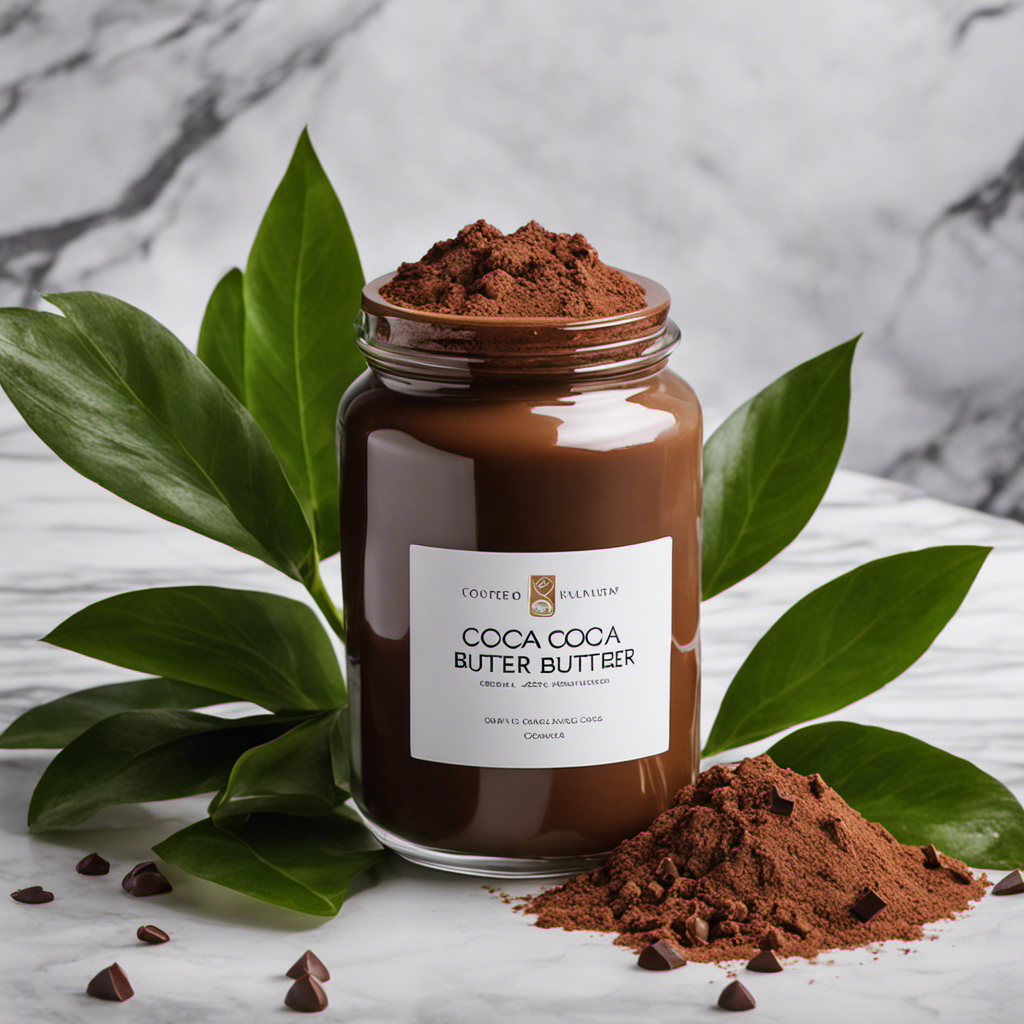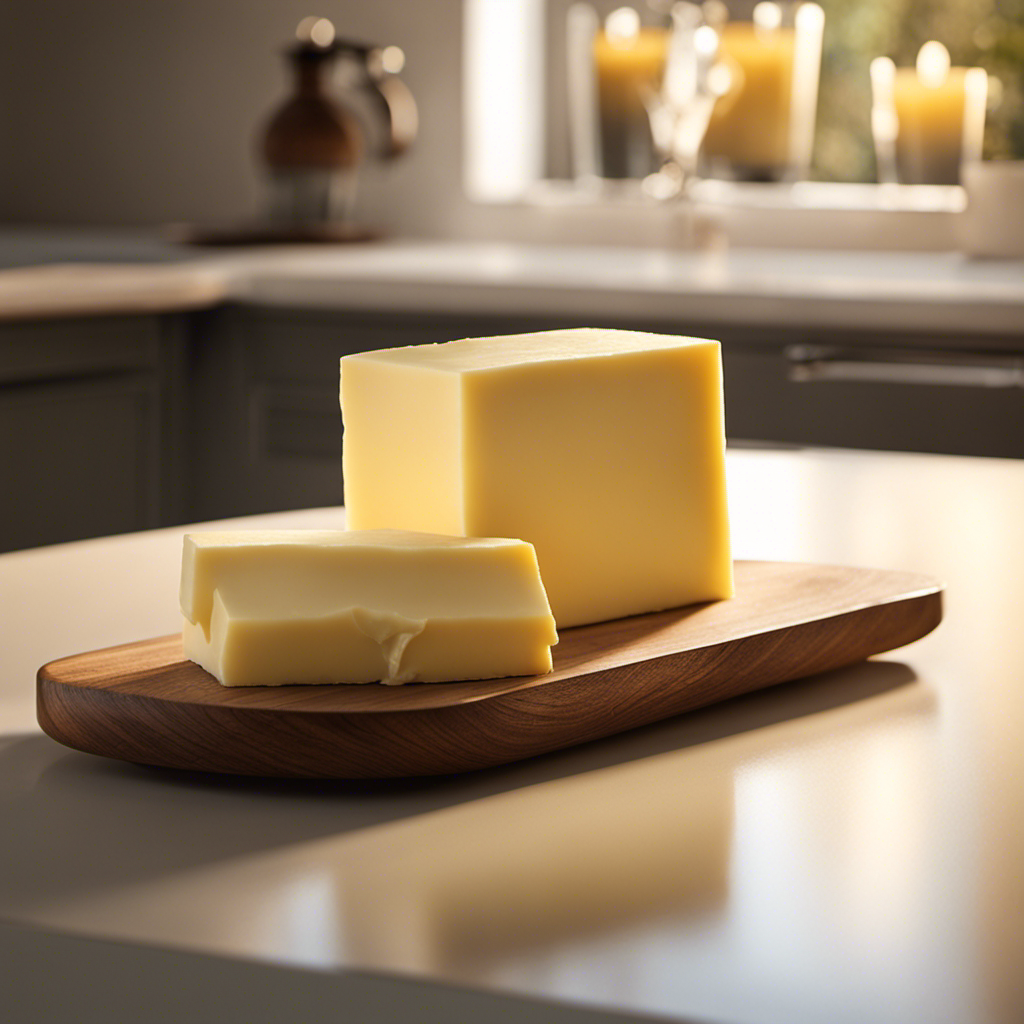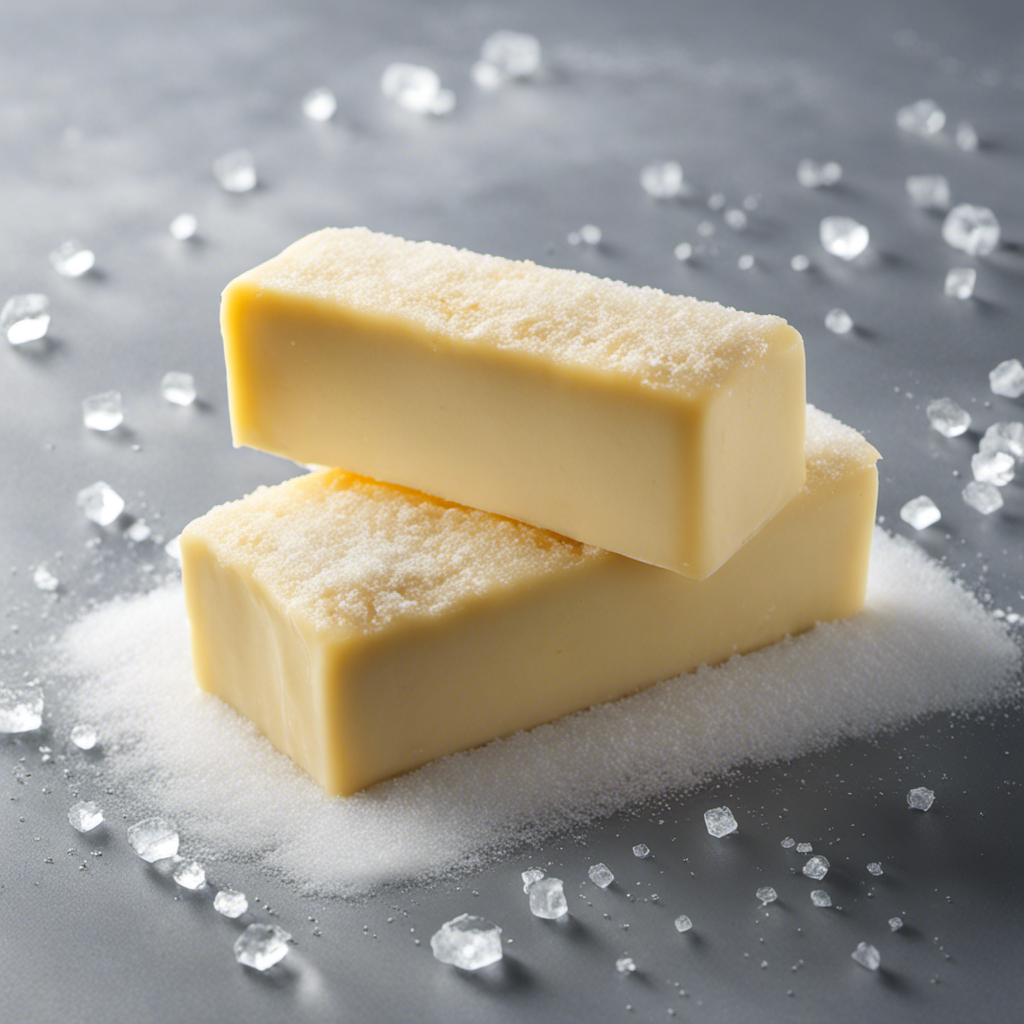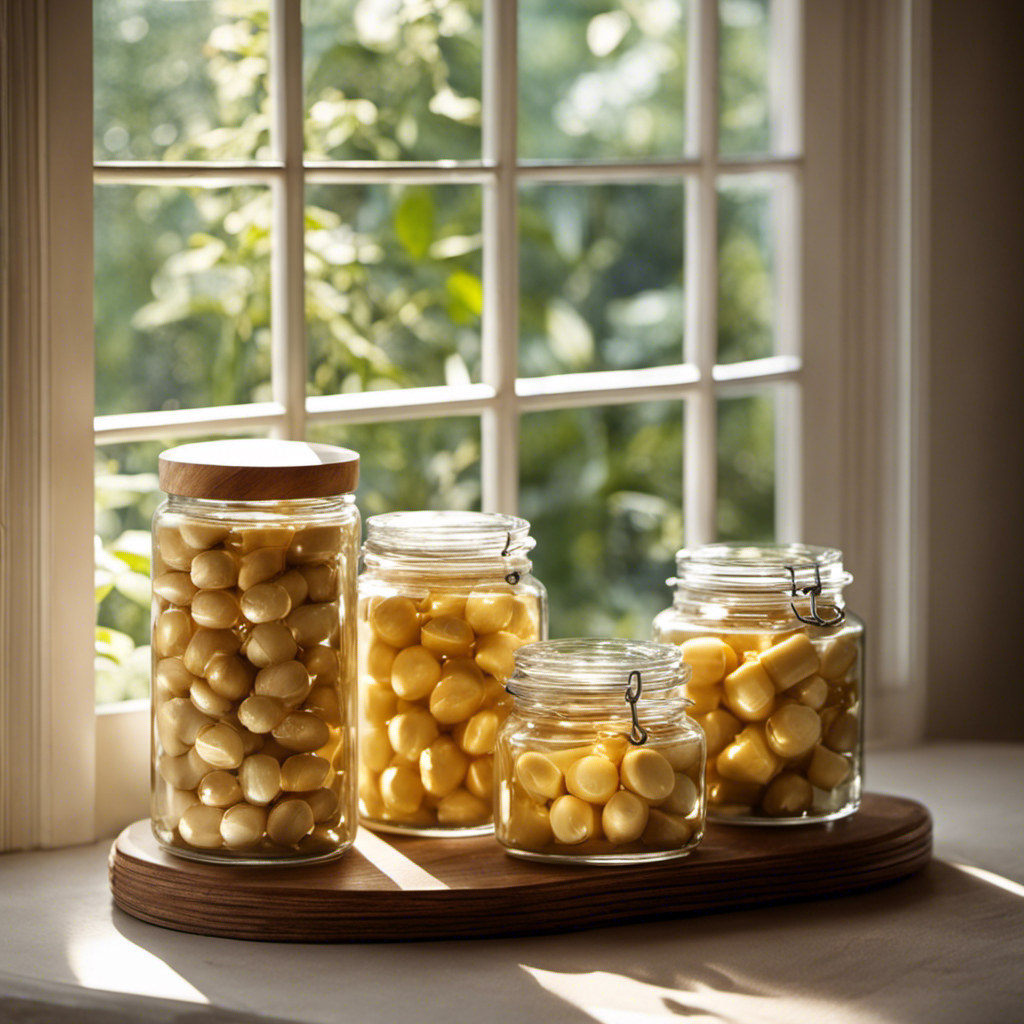I have always been curious about the shelf life of cocoa butter. It is a luxurious ingredient, and I want to ensure that I am maximizing its benefits.
So, I did some research to find out the truth about cocoa butter’s shelf life. In this article, we’ll explore the factors that affect how long cocoa butter lasts and discover the best storage tips to extend its lifespan.
Get ready to dive into the science behind preserving this precious ingredient!
Key Takeaways
- Factors affecting the shelf life of cocoa butter include rancidity due to oxidation, presence of moisture promoting microorganism growth, and temperature impacting oxidation process.
- Storage tips for extending the lifespan of cocoa butter include storing in a cool, dry place, using an airtight container, keeping away from direct sunlight, and avoiding storing near strong-smelling substances.
- Signs of spoiled cocoa butter include a change in smell (strong and unpleasant odor) and a change in texture (grainy, waxy, or chalky appearance).
- The best before date on cocoa butter packaging is relatively long, lasting up to two years, and its accuracy depends on factors such as storage conditions and water content.
Factors Affecting the Shelf Life of Cocoa Butter
There are several factors that can affect the shelf life of cocoa butter.
One of the main factors is rancidity. Rancidity occurs when the fats in cocoa butter are exposed to oxygen and undergo oxidation, leading to the development of off-flavors and odors. This can significantly impact the quality and taste of the final product.
Another factor that affects the shelf life of cocoa butter is the presence of moisture. Moisture can promote the growth of microorganisms, leading to spoilage and a decrease in product efficacy.
Additionally, temperature plays a crucial role in determining the shelf life of cocoa butter. High temperatures can accelerate the oxidation process, while low temperatures can prolong the shelf life by slowing down chemical reactions.
Understanding these factors is essential for manufacturers and consumers to ensure the freshness and effectiveness of cocoa butter-based products.
Storage Tips for Extending the Lifespan of Cocoa Butter
To extend the lifespan of your cocoa butter, make sure you store it in a cool, dry place. Proper storage is crucial for preserving cocoa butter’s quality and extending its freshness. Exposure to heat, light, and moisture can accelerate the deterioration process and lead to rancidity.
It is recommended to keep cocoa butter in an airtight container, away from direct sunlight, and at a temperature below 70°F (21°C). Additionally, avoid storing it near strong-smelling substances as cocoa butter easily absorbs odors.
By following these storage tips, you can maximize the shelf life of your cocoa butter and maintain its optimal quality for a longer period.
Now, let’s explore the signs of spoiled cocoa butter and how to identify them.
Signs of Spoiled Cocoa Butter and How to Identify Them
Storing cocoa butter in a warm and humid environment can cause it to spoil quickly.
As a researcher in the field of food science, I have extensively studied the signs that indicate cocoa butter has gone rancid.
One of the most evident signs is a change in smell. Rancid cocoa butter has a strong and unpleasant odor, similar to that of spoiled oil.
Another indicator is a change in texture. Rancid cocoa butter becomes grainy and develops a waxy or chalky appearance.
To prevent cocoa butter from spoiling, it is crucial to store it in a cool and dry place, away from direct sunlight.
Additionally, using airtight containers can help to preserve its freshness and extend its shelf life.
Regularly inspecting the cocoa butter for any signs of spoilage is also recommended.
Understanding the Best Before Date on Cocoa Butter Packaging
As a researcher in the field of food science, I’m interested in exploring the shelf life of cocoa butter and the accuracy of expiration dates.
Cocoa butter, a key ingredient in many chocolate products, has a relatively long shelf life due to its low water content and high melting point.
However, it’s essential to examine the accuracy of expiration dates to ensure the quality and safety of cocoa butter-based products.
Shelf Life of Cocoa Butter
When properly stored, cocoa butter can last for up to two years. Several factors can affect the quality and shelf life of cocoa butter.
One important factor is the storage conditions. Cocoa butter should be stored in a cool, dark place, away from heat and sunlight, as exposure to these elements can cause it to deteriorate. Additionally, moisture can also impact the quality of cocoa butter, so it is essential to keep it in an airtight container to prevent any contact with water.
The benefits of cocoa butter extend beyond its longevity. It is a rich source of antioxidants and healthy fats, which can help improve skin health and reduce inflammation.
As we delve into the topic of expiration date accuracy, it is crucial to understand the factors influencing the shelf life of cocoa butter.
Expiration Date Accuracy
After discussing the shelf life of cocoa butter, it is important to consider the reliability of expiration dates and the impact of storage conditions.
As a researcher, I have found that expiration dates on cocoa butter products are usually accurate when stored under optimal conditions. However, it is crucial to note that the reliability of expiration dates depends on various factors, including the quality of the product, packaging, and storage conditions.
Cocoa butter should be stored in a cool, dry place away from direct sunlight and strong odors to maintain its quality and extend its shelf life. Exposure to heat, moisture, and air can accelerate the degradation process, reducing the reliability of the expiration date.
Therefore, it is recommended to follow proper storage guidelines to ensure the longevity and reliability of cocoa butter.
Properly Storing Cocoa Butter in Different Environments
Storing cocoa butter in different environments properly can help extend its shelf life. It is essential to use suitable storage methods and recommended containers to ensure optimal preservation.
The first consideration is temperature. Cocoa butter should be stored in a cool, dry place, away from direct sunlight and heat sources. Exposure to high temperatures can cause it to melt or become rancid.
Additionally, moisture must be avoided to prevent the growth of mold or bacteria. Airtight containers, such as glass jars or metal tins, are recommended to protect the cocoa butter from air exposure, which can lead to oxidation and degradation of its quality.
Following these storage guidelines will help maintain the freshness and stability of cocoa butter for an extended period.
How Temperature and Humidity Impact the Longevity of Cocoa Butter
When it comes to the longevity of cocoa butter, temperature plays a crucial role. Fluctuations in temperature can significantly impact the shelf life of cocoa butter, causing it to deteriorate more quickly.
Similarly, humidity levels also play a vital role in determining the spoilage of cocoa butter, as high humidity can lead to the growth of mold and bacteria.
Furthermore, temperature and humidity can also affect the quality of cocoa butter, altering its texture, flavor, and overall sensory attributes.
Temperature and Shelf Life
If you keep cocoa butter at the right temperature, it can last for a long time. Proper storage is essential to maintain the quality and longevity of cocoa butter. Here are some important factors to consider:
-
Temperature: Cocoa butter should be stored at a consistent temperature between 60-70°F (15-21°C). Fluctuations in temperature can cause the butter to melt and solidify, potentially leading to a shorter shelf life.
-
Avoid direct sunlight: Exposure to sunlight can accelerate the oxidation process, causing the cocoa butter to spoil more quickly. Store it in a cool, dark place to preserve its freshness.
-
Airtight container: To prevent moisture and air from affecting the cocoa butter, store it in a tightly sealed container. This will help maintain its quality and extend its shelf life.
-
Melting point: Cocoa butter has a melting point of around 93-101°F (34-38°C). Avoid exposing it to temperatures above its melting point, as this can cause the butter to lose its structure and affect its quality.
Humidity and Spoilage
To prevent spoilage of your cocoa butter, it’s important to store it in a low humidity environment. Humidity can greatly impact the effectiveness and shelf life of cocoa butter. High humidity levels promote mold growth, which can lead to spoilage and make the cocoa butter unsafe for consumption. Additionally, excessive moisture can cause the cocoa butter to become rancid and develop an unpleasant odor and taste. Therefore, it is crucial to keep cocoa butter in a cool, dry place, away from direct sunlight and moisture. This will help maintain its quality and extend its shelf life. Here is a table that illustrates the impact of humidity on cocoa butter:
| Humidity Level | Impact on Cocoa Butter |
|---|---|
| Low | Minimal to no impact |
| Moderate | Slight degradation |
| High | Increased spoilage |
| Very high | Significant spoilage |
| Extreme | Rapid deterioration |
Impact on Cocoa Quality
In my previous discussion on the impact of humidity on cocoa butter spoilage, I explored the factors that contribute to the degradation of this valuable ingredient. Now, I will delve into the broader implications of cocoa quality and its significance in cocoa butter production and applications.
Here are four key points to consider:
-
Cocoa Quality Standards: To ensure the production of high-quality cocoa butter, strict standards are set for cocoa beans, including size, fermentation, and moisture content.
-
Flavor and Aroma: Cocoa quality directly affects the flavor and aroma of cocoa butter, making it crucial for applications in gourmet chocolates, confections, and cosmetics.
-
Processing Techniques: Proper processing techniques, such as roasting, grinding, and pressing, are employed to extract cocoa butter with optimal quality and functionality.
-
Shelf Life: The quality of cocoa butter also impacts its shelf life, as higher-quality butter tends to have a longer storage period before rancidity sets in.
Understanding the impact of cocoa quality on cocoa butter production and applications is essential for maintaining the integrity and desirability of this versatile ingredient.
Shelf Life of Homemade Cocoa Butter Products
You should be aware that homemade cocoa butter products have a limited shelf life.
When it comes to homemade cocoa butter recipes, it is important to consider the benefits of cocoa butter in skincare as well as its potential expiration date.
Cocoa butter is known for its moisturizing properties and ability to improve skin elasticity, making it a popular ingredient in DIY skincare products.
However, due to its high fat content, homemade cocoa butter products can become rancid over time. Exposure to heat, light, and air can accelerate the degradation process.
To ensure the longevity of your homemade cocoa butter products, it is crucial to store them in a cool, dark place and use airtight containers.
Extending the Lifespan of Cocoa Butter in Beauty and Skincare Products
By following proper storage techniques, you can ensure your homemade cocoa butter products stay fresh for longer. To prevent rancidity and preserve the delightful cocoa aroma, here are four key methods to extend the lifespan of your cocoa butter in beauty and skincare products:
-
Keep it in a cool, dark place: Exposure to heat and light can accelerate the breakdown of cocoa butter, leading to rancidity. Store it in a cool, dark cupboard or refrigerator to maintain its freshness.
-
Use airtight containers: Oxygen can also contribute to the oxidation of cocoa butter. Transfer your homemade products into airtight containers to minimize oxygen exposure and preserve its quality.
-
Avoid water contamination: Water can introduce moisture and promote the growth of bacteria, which can degrade cocoa butter. Ensure your containers and utensils are completely dry before use.
-
Limit exposure to air: Every time you open your cocoa butter container, it exposes the product to air. Use smaller containers or divide your cocoa butter into portions to reduce air exposure.
Frequently Asked Questions
Can Cocoa Butter Expire?
Yes, cocoa butter can expire. However, it has a long shelf life if stored properly. It offers numerous benefits such as moisturizing the skin and promoting healing. To maximize its longevity, store cocoa butter in a cool, dry place.
Can I Still Use Cocoa Butter if It Has Changed Color or Texture?
If cocoa butter has changed color or texture, it may be a sign that it has spoiled. It is important to check the shelf life of cocoa butter and discard it if it is past its expiration date or shows signs of spoilage.
Is It Safe to Use Cocoa Butter Past Its Best Before Date?
Using cocoa butter past its best before date is safe. It may lose some potency, but it’s like a faded painting still hanging on the wall. To maximize shelf life, store it in a cool, dark place. It’s great for skincare routines, with its many benefits.
Can I Store Cocoa Butter in the Refrigerator to Prolong Its Shelf Life?
Refrigerating cocoa butter can extend its shelf life. However, it’s important to note that using expired cocoa butter may not be as effective. It’s best to check the expiration date and use fresh cocoa butter for optimal results.
Can Cocoa Butter Go Bad if Stored in a High-Humidity Environment?
In a high-humidity environment, cocoa butter can go bad due to moisture absorption. Temperature also plays a role, as higher temperatures can accelerate the oxidation process. Packaging that is not airtight or allows moisture ingress can further reduce shelf life.
Conclusion
In conclusion, understanding the factors that affect the shelf life of cocoa butter is crucial in maximizing its longevity. By following proper storage tips and being aware of signs of spoilage, we can ensure that our cocoa butter remains fresh and usable for a longer period of time.
Just like a well-preserved treasure, cocoa butter can be likened to a precious gem that retains its beauty and effectiveness when stored correctly. So, let’s take care of our cocoa butter like a precious gem, and enjoy its benefits for as long as possible.










